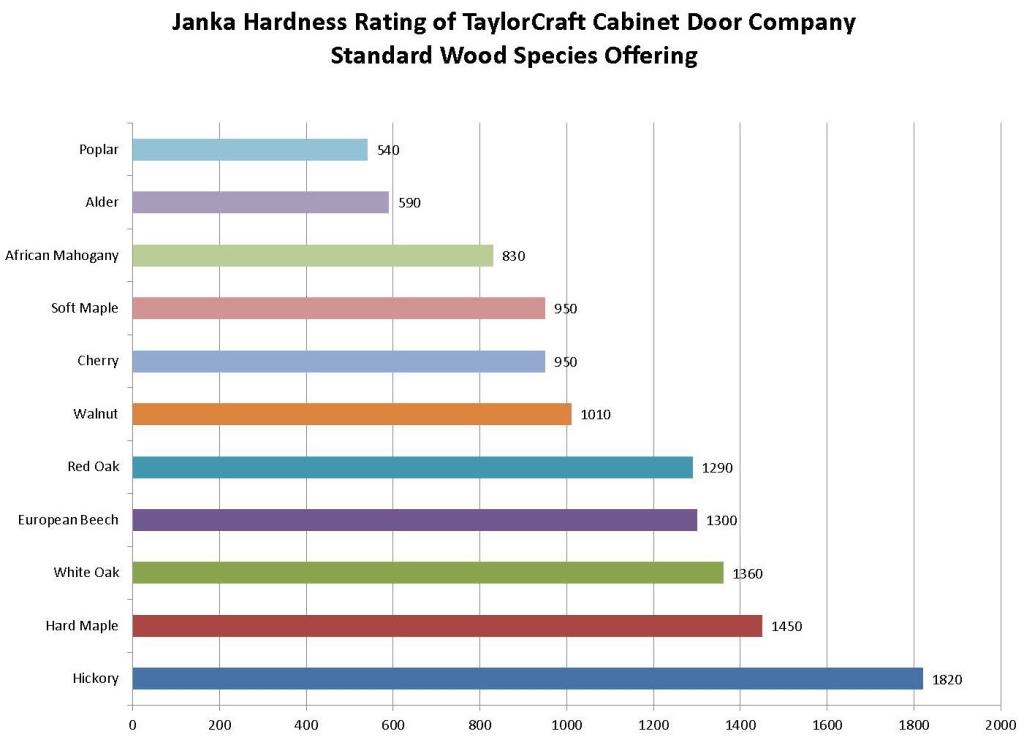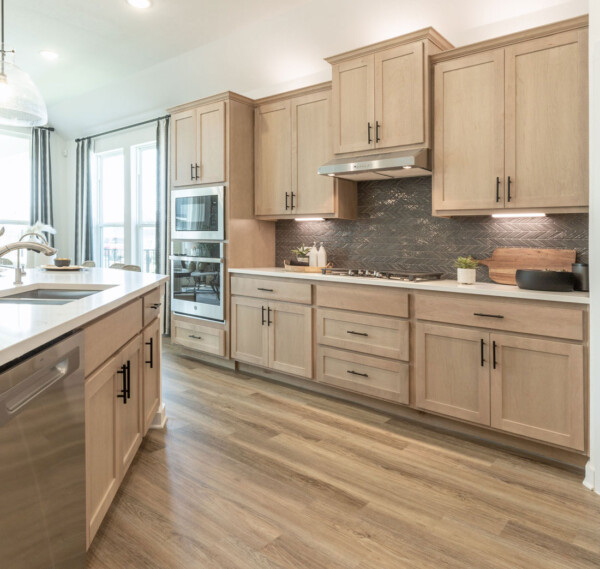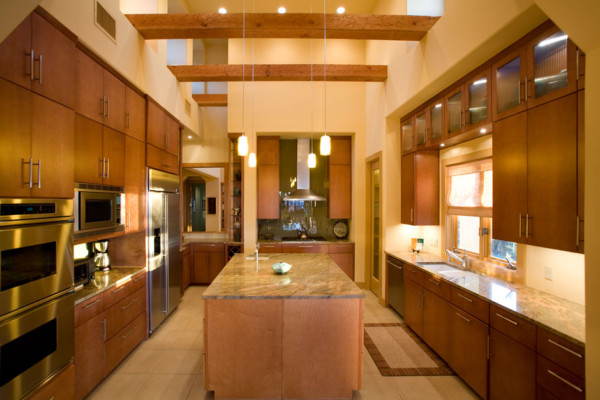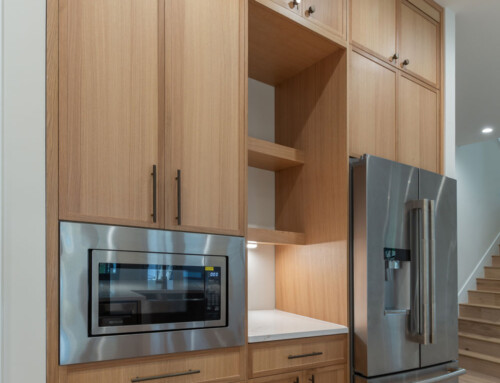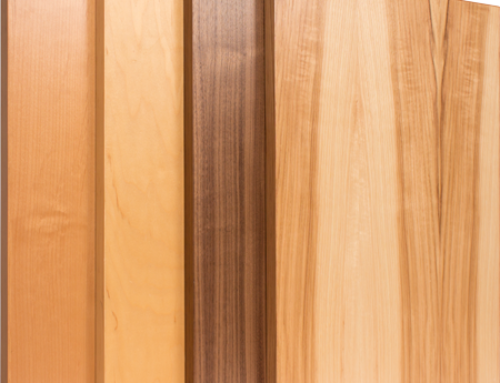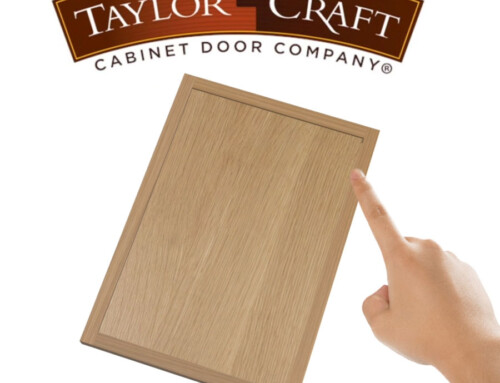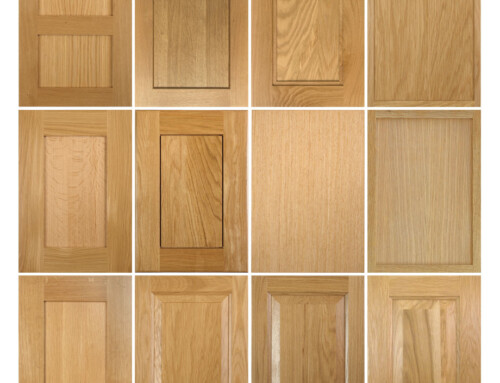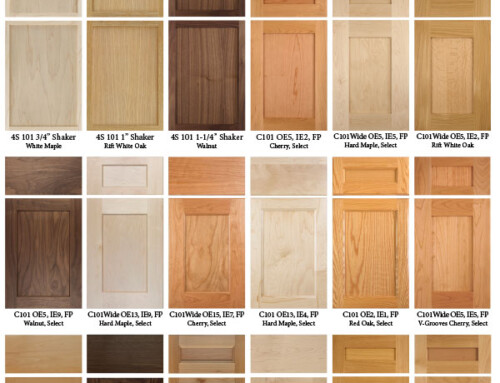We are often asked about the differences between hard and soft maple as a material choice for cabinet doors, other than the obvious price difference, which can be significant. To answer this question and aid in the cabinet door selection process, below is an overview of the main similarities and differences between hard maple and soft maple. Be sure to check out the bottom of the page to see maple kitchens for some design inspiration.
How Much Harder is Hard Maple than Soft Maple?
Despite being called soft maple, both hard and soft maple are considered hard woods. Soft maple holds the same hardness rating as cherry at 950 on the Janka Hardness Rating Scale, making it harder than African mahogany at 830, alder at 590 and poplar at 540. Hard maple comes in at 1450 on the Janka Hardness Rating Scale, which puts it at the upper end, and makes it a preferred choice for flooring, baseball bats, bowling alleys, violins and butcher blocks. Hard maple grows more slowly, which makes the wood harder but also increases the time to harvest and makes it more costly.
One unscientific but simple way to test the hardness of a piece of maple is to push your fingernail into the back or hard edge of the lumber or cabinet door. If it dents easily it is most likely soft maple. If the wood is hard and your fingernail does not leave much of a mark, it is most likely hard maple.
Janka Hardness Rating Scale
What is the Weight Difference between Hard Maple and Soft Maple?
Hard maple typically weighs more than soft, at 44 pounds per cubic foot compared to 32-40 pounds per cubic foot depending on the specie for soft maple. Big leaf soft maple weighs 34 pounds per cf, red leaf soft maple weighs 38 pounds per cf, and silver maple weighs 33 pounds per cf. The weight of soft maple can vary plus or minus 10 percent so it can’t always be used to reliably determine the species.
Machining Considerations for Hard Maple and Soft Maple
Soft maple machines more easily and doesn’t show burn marks as much as hard maple, however it can fuzz when machined if the tooling is not really sharp, so it is not preferred by wood turners. Hard maple is very hard and very smooth and tends show burn marks more readily than soft maple. In either case, extremely sharp, premium blades and properly aligned equipment can minimize tooling issues.
Hard Maple and Soft Maple Color and Grain Pattern
Hard Maple grows more slowly than soft, so typically the grain is close together due to close growth rings, and the growth rings are more pronounced than on soft maple. On soft maple, growth rings tend to be less visible. Hard maple is not likely to have wide growth rings but soft maple can have tight growth rings. Color and grain can be very similar in appearance and can be hard to tell apart visually but if you take into consideration all of the differences mentioned in this article, you can usually tell the species apart.
Finishing Considerations for Hard and Soft Maple
Finishing maple can be tricky, whether you are using hard or soft maple, because of the wide variability in the porousness of the finished surface. Stain color can be absorbed unevenly if the surface isn’t prepared properly, creating a blotchy appearance. There are a number of solutions to this issue, from sanding and material selection to pre-stain conditioners or shellac. Even with the correct products and preparation, expectations of an acceptable finished look vary widely. Always show the buyer a finished sample in their chosen color so there is no ambiguity, and always test your finishing methods before using a new method or color on an entire job. For great finishing advice refer to Bernie Bottens’ wood finishing blog at http://www.woodworkingnetwork.com/wood-blogs/fine-woodworking/custom-bernie-bottens/Blotching-A-Woodworkers-Nightmare-151897695.html#sthash.1HUESgQY.zQ7tiwEb.dpbs
Below are TaylorCraft Cabinet Door Company’s general material descriptions for hard and soft maple. If you or your customers are not familiar with the species or our grading, we strongly recommend ordering a sample to prevent any misunderstanding.
Select Hard Maple will be clear of defects, and the inherent color, character marks and grain patterns will be closely inspected and matched to create a more uniform appearance than our natural grades. Heartwood will be not visible on the face. Select grade is recommended when reduced variation in appearance is desired or when used with clear or lightly stained finishes. General characteristics of Hard Maple are: light blond in color with creamy white sapwood with a slight pinkish cast and heartwood that varies in color from tan to dark reddish brown. The wood has a fine uniform texture and is generally straight-grained, but may also include small amounts birdseye, curly or fiddleback figure.
Natural Hard Maple will be clear of pronounced defects but will possess inherent characteristics of the species in which only the extremes will be removed. It may contain some narrow staves, sapwood, heartwood and pin knots. Expect a wide range of color throughout the entire order. Natural grade is recommended when natural color and grain variations are desired or acceptable such as when used with medium to dark stained finishes, however even with a darker finish, some color variations from stave to stave may still be visible due to variations in material composition. General characteristics of Hard Maple are: light blond in color with creamy white sapwood with a slight pinkish cast and heartwood that varies in color from tan to dark reddish brown. The wood has a fine uniform texture and is generally straight-grained, but may include birdseye, curly or fiddleback figure.
Select Soft Maple will be clear of defects, and the inherent color, character marks and grain patterns will be closely inspected and matched to create a more uniform appearance than our Natural grades. This grade is recommended when using a natural to light stain color. General Characteristics of Soft Maple are: generally straight grained with sapwood that is light blond, sometimes with a grey cast, with occasional dark brown flecks and heartwood that varies from light to dark reddish brown. Soft Maple is generally around 25% softer than Hard Maple and therefore accepts stain differently than Hard Maple.
Natural Soft Maple will be clear of pronounced defects but will possess inherent characteristics of the species in which only the extremes will be removed. It may contain some narrow staves, sapwood, heartwood and pin knots. Expect a wide range of color throughout the entire order. Natural grade is recommended when natural color and grain variations are desired or acceptable such as when used with medium to dark stained finishes, however even with a darker finish, some color variations from stave to stave may still be visible due to variations in material composition.. General Characteristics of Soft Maple are: generally straight grained with sapwood that is light blond sometimes with a grey cast and with occasional dark brown flecks and heartwood that varies from light to dark reddish brown. Soft Maple is generally around 25% softer than Hard Maple and therefore accepts stain differently.
Hard Maple vs. Soft Maple as a Wood Species
Soft maple can actually be one of several species of maple with big leaf the predominant species in the Northwest, and red or silver maple on the east coast. Hard maple refers to just one species, acer saccharum (aka rock or sugar maple), and it is the species from which we get maple syrup.
We welcome your feedback and would love to see photos of hard or soft maple projects you have completed. Here are a couple of kitchens completed using TaylorCraft Cabinet Door Company’s Select Hard Maple cabinet doors for inspiration:



